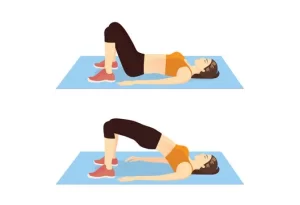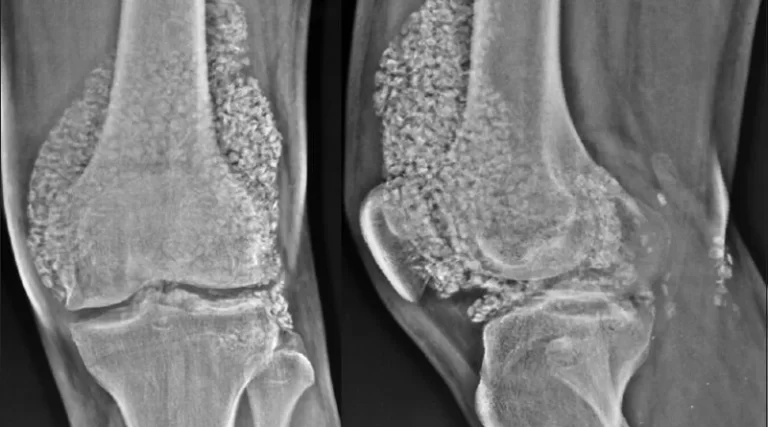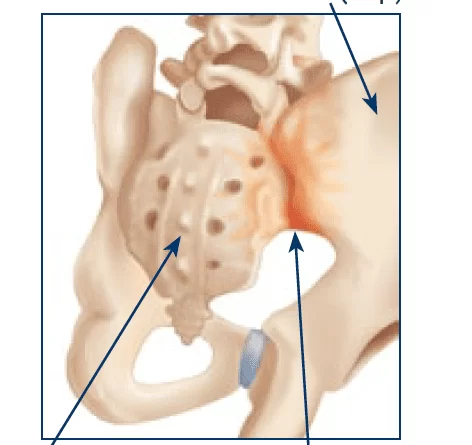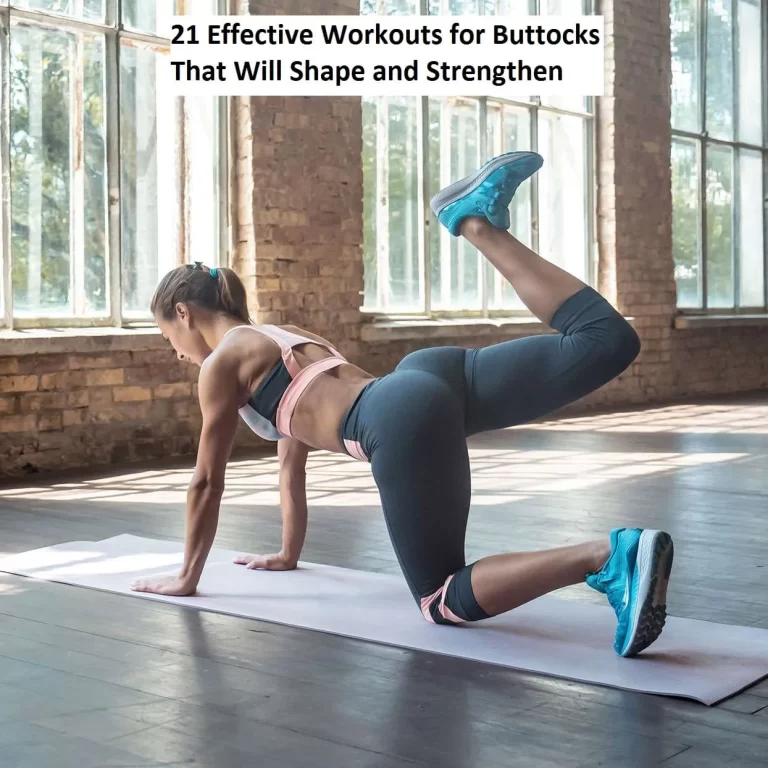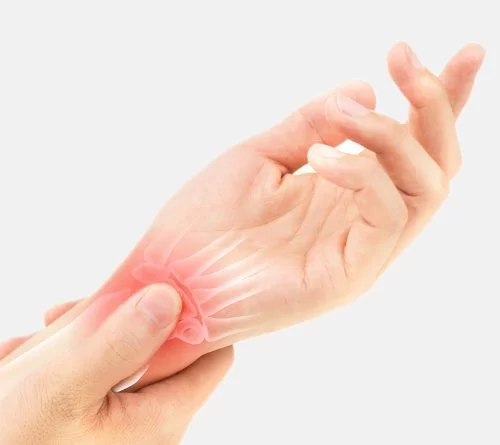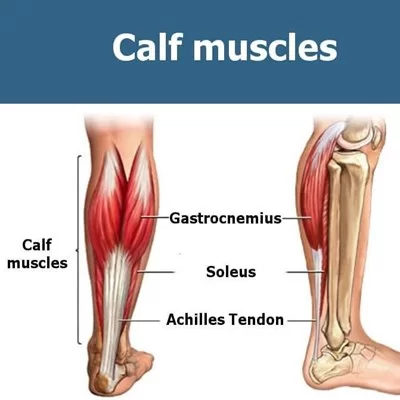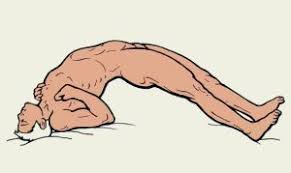16 Best Exercise For Guillain-Barre Syndrome (GBS)
Table of Contents
Introduction:
The immune system of the body mistakenly attacks peripheral nerves, resulting in Guillain-Barré Syndrome (GBS), a rare autoimmune neurological disorder. In Physiotherapy, Exercise For Guillain-Barré Syndrome (GBS) is essential for regaining independence, function, and mobility in people with Guillain-Barré Syndrome (GBS).
If a patient has Guillain-BarréSyndrome (GBS), exercise should be started immediately and continued until the patient recovers as much as possible. Physiotherapy rehabilitation aims to strengthen muscles, preserve joint ranges of motion, and retrain natural movement patterns necessary for normal function and independent living.
For individuals with Guillain-Barré Syndrome (GBS) to restore their coordination and functional independence, physiotherapy is crucial. Before beginning bed mobility exercises to improve strength and coordination, passive range-of-motion exercises may be recommended to avoid joint stiffness. More strenuous activities could be recommended when the patient’s health improves in order to increase muscular strength, cardiovascular fitness, and functional independence.
Restoring strength and mobility can be done easily and practically with physiotherapy. Guillain-Barré Syndrome (GBS) may seem isolating, but with the correct technique, you may regain your regular rhythm. Always get the guidance of a physiotherapist for personalized solutions that are suitable for you.
For those with Guillain-Barré Syndrome (GBS), it’s crucial to approach fitness and physiotherapy cautiously. Some people with the illness may experience a temporary increase in their symptoms due to excessive or rapid movements. Therefore, to guarantee a secure and effective recovery process, a customized treatment strategy is advised.
Causes:
It is unclear exactly what causes Guillain-Barré Syndrome (GBS), an autoimmune condition in which the body’s immune system unintentionally targets its own peripheral nerves.
Physical trauma or surgery
- Occasionally, Guillain-Barré Syndrome (GBS) has arisen during surgery, particularly gastrointestinal or orthopedic treatments.
- Following physical trauma or spinal damage as well.
Autoimmune Disorders
- Although Guillain-Barré Syndrome (GBS) is an autoimmune condition in and of itself, certain individuals may be at a higher risk if they already have autoimmune disorders.
Vaccinations
- Though the risk of contracting Guillain-Barré Syndrome (GBS) from the vaccine is far smaller than the chance of contracting it from the virus itself (such as the flu), Guillain-Barré Syndrome (GBS has been connected to certain vaccinations.
Signs and symptoms:
You can better understand how Guillain-Barré Syndrome (GBS) often presents and progresses by using the following symptoms.
The legs are weak.
- An inconsistent stride, problems walking, or difficulty climbing stairs may be the first things you notice.
- Usually arranged symmetrically, this weakness affects both sides of the body simultaneously.
Cramps or Pain in the Muscles
- Some patients suffer from severe, especially at night, deep or throbbing muscular pain, usually in the legs or back.
Sensory Signs
- Tingling, burning, or numbness in the affected regions.
- It might not be as severe as muscular weakness.
Exercise’s advantages:
Promotes Emotional and Mental Well-Being
- Engaging in physical activity might alleviate the anxiety, sadness, and frustration that are frequently linked to prolonged recovery.
- Builds self-assurance and being independent via visible advancement.
Enhance Strength and Muscle Endurance
- The Guillain-Barré Syndrome (GBS) can cause severe muscle weakness or even paralysis.
- Exercise improves endurance, helps regain lost muscle strength, and prevents muscular atrophy.
Increases Mobility and Flexibility
- Mild stretching and movement increase joint range of motion and flexibility.
- Restoring nerve function promotes improved walking ability, balance, and coordination.
Reduces Fatigue
- Although it may seem strange, regular activity at the right speed might actually help in reducing the extreme fatigue that is a typical and frequently persistent symptom of Guillain-Barré Syndrome (GBS).
- Enhancing muscle efficiency and cardiovascular health gives the body greater energy for daily tasks.
Improves Functional Independence
- Exercise helps people restore their capacity to carry out activities of daily living (ADLs) by restoring their strength and mobility.
- This covers activities including walking, eating, dressing, and getting out of bed.
- The patient’s quality of life and sense of self-worth depend on recovering that independence.
Improves Balance and Coordination
- Proprioception, the body’s sense of its location in space, can be interfered with by GBS.
- By retraining the neural system, targeted balance and coordination exercises help people become more stable and lower their risk of falling.
Enhances Cardiovascular Health
- Walking and stationary cycling are examples of aerobic workouts that help in regaining endurance.
- Promotes lung and heart health during periods of bed rest or inactivity.
Before beginning an exercise program, the following safety measures should be taken into consideration.
- It’s important to consider a few safety measures and enhance the benefits before beginning any health program.
- To find out which exercises are best for your particular problem, speak with your doctor or a physiotherapist.
- When something feels uncomfortable, you should listen to your body’s demands and refrain from pushing yourself.
- Even while soreness is a common side effect of exercise, persistent or severe pain could indicate overwork.
- Start with low-impact exercises until you can tolerate more pain, then work your way up to more challenging ones.
- By maintaining proper form and posture, repetitive injuries can be prevented.
- A doctor should be consulted if you are unsure about how to begin exercising correctly.
- To prepare your muscles and joints for the activity, warm them up before beginning.
Exercise for ForGuillain-Barrée Syndrome (GBS):
One of the most difficult symptoms of Guillain-Barré Syndrome (GBS) is muscle weakness. Maintaining independence might be difficult when one’s strength declines. For stronger muscles, try these exercises for Guillain-Barré Syndrome (GBS)
Deep breathing exercises
Deep breathing steps:
- Sit on the ground in a comfortable position.
- Breathe in via your nose.
- Let the air fill your stomach.
- Use your nose to exhale.
- Place a hand over your stomach.
- Place the other hand against your chest.
- As you inhale, feel your stomach expand.
- When you exhale, feel your stomach lower.
- The hand on your abdomen should move more than the one on your chest.
- As you breathe deeply, notice how your tummy rises and falls with each breath.
- Then return to your neutral position.
- Then relax.
- Repeat these exercises 5 to 10 times.
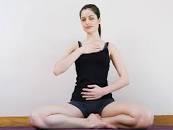
Walking
- One of the easiest and best ways to exercise is to go for a walk.
- To prepare your muscles, begin by walking at a slow speed for 5 to 10 minutes.
- After your walk, take a five-minute break and stretch your muscles gently.
- Then return to your neutral position.
- Then relax.
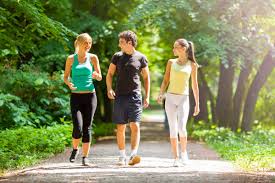
Ankle circle
- Take a seat comfortably.
- Cross one ankle over the other knee or extend one leg straight out in front of you.
- Make a slow circular motion with your foot near the ankle.
- Make 10–20 clockwise circles.
- Next, make 10–20 counterclockwise circles.
- Make sure to isolate the action at the ankle joint by keeping it gradual and controlled.
- Then return to your neutral position.
- Then relax.
- Repeat these exercises 5 to 10 times.
- Do the same with the opposite ankle.
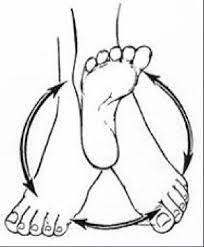
Ankle pump
- Stretch your legs out and begin lying on your back.
- As much as you can, slowly and softly point your toes away from your body.
- Both your shin and the top of your foot should feel stretched.
- As much as you can, gently but surely move your toes back toward your head.
- The muscles in your calves should feel stretched.
- Hold this position for a few seconds.
- Then return to your neutral position.
- Then relax.
- Repeat these exercises 5 to 10 times.
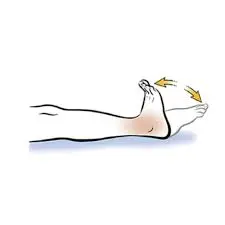
Elbow bend
- You can sit or stand with your arm at your side.
- To raise your hand toward your shoulder, gently bend your elbow.
- Hold this position for a few seconds.
- After that, carefully drop your arm back down until it is completely straight.
- Then return to your neutral position.
- Then relax.
- Repeat these exercises 5 to 10 times.

Heel slide
- On a level, stable surface, lie on your back.
- Then both legs are extended in front of you.
- Maintain a neutral posture and a flat back.
- Bend one knee slowly and move the heel of that foot toward your buttocks along the surface.
- Slide your heel as far as you can without experiencing any pain or until you feel a slight stretch.
- Hold this position for a few seconds.
- Then return to your neutral position.
- Then relax.
- Repeat these exercises 5 to 10 times.
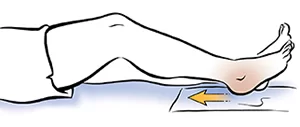
Static quadriceps strengthening
- You can straighten your legs and sit on the floor.
- You can lay a cushion or a small, rolled-up towel just behind your knee to help with the workout.
- Press the rear of your knee into the towel or the surface.
- You should feel the muscles on top of your thigh squeeze and tighten as you perform this.
- The front of your leg muscles should tighten, and your kneecap should rise a little.
- Hold this position for a few seconds.
- Then slowly release the contraction.
- Then return to your neutral position.
- Then relax.
- Repeat these exercises 5 to 10 times.

Seated knee extension
- With your back straight, take a seat in a stable chair.
- Putting your feet level on the ground.
- One leg should be straightened slowly and carefully until it is parallel to the floor.
- The muscles on the front of your thigh should get tighter as you perform this.
- Hold this position for a few seconds.
- Lower your foot carefully and slowly.
- Then return to your neutral position.
- Then relax.
- Repeat these exercises 5 to 10 times.
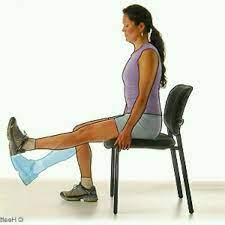
Bridging
- On a mat or other soft surface, lie on your back.
- Then bend your knees.
- Your feet should be hip-width apart and level on the ground.
- You should place your heels such that your fingertips may easily touch them.
- Your arms should be at your sides.
- Your palms should remain flat on the ground.
- Engage your abdominal muscles gently before lifting.
- Exhale as you raise your hips off the ground by squeezing your glutes and pressing through your heels.
- Lifting should continue until your body is in a straight line.
- Don’t raise so much that your lower back starts to hurt.
- Hold this position for a few seconds.
- Then return to your neutral position.
- Then relax.
- Repeat these exercises 5 to 10 times.
Step up
- Go for a box or step that is solid and strong.
- It shouldn’t be so high that you have to jump or struggle to get your foot on top, but it should be difficult enough.
- Place your feet shoulder-width apart and stand in front of the step.
- Firmly plant your right foot in the middle of the step.
- Step up onto the box by leaning slightly forward and pushing off your left foot using your right leg’s power.
- On top of the step, move your left foot to meet your right foot.
- Make sure your right leg is completely extended at the top.
- With your left foot in the lead, take a step back down to the starting position.
- Then return to your neutral position.
- Then relax.
- Repeat these exercises 5 to 10 times.
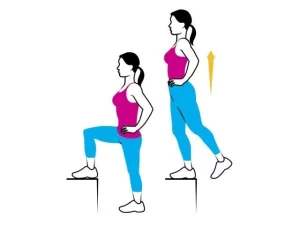
Squat
- The distance between your feet should be somewhat more than hip-width.
- Toes should be pointed slightly outward.
- Maintain a neutral spine, a raised chest, and back shoulders.
- For balance, you can extend your arms out in front of you.
- Push your hips back as though you were going to sit on a chair to start.
- Additionally, bend your knees.
- Maintain a straight back and a raised chest as you keep going down your body.
- Hold this position for a few seconds.
- Push back up to the beginning posture by squeezing your glutes and pushing through your heels.
- Ensure that your hips and chest lift at the same pace.
- Then return to your neutral position.
- Then relax.
- Repeat these exercises 5 to 10 times.
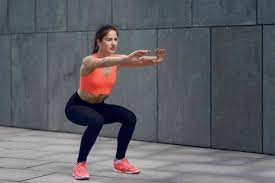
Lunges
Lunge steps:
- Place your feet hip-width apart as you stand.
- Maintain a neutral spine, shoulders back, and an upright chest.
- Step forward with your right leg in a big step.
- Lower your hips until your back and front knees are 90 degrees bent.
- A straight back and an upright body are essential. Refrain from bending forward too much.
- Hold this position for a few seconds.
- To go back to the starting position, push off your front foot.
- Then return to your neutral position.
- Then relax.
- Repeat these exercises 5 to 10 times.
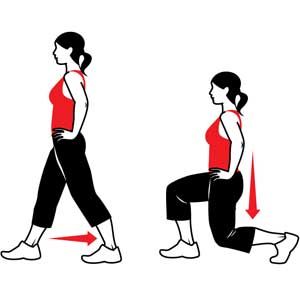
Seated calf stretch
- Stretch your legs out and sit on the floor.
- Maintain a straight back and as straight a knee as you can.
- Wrap the heel of your right foot with a cloth, strap, or fitness band.
- Using your hands, grasp the towel’s ends.
- Pull the cloth gently till your toes are in contact with your body.
- Maintain a straight leg.
- The back of your calf should feel stretched.
- Hold this position for a few seconds.
- Then return to your neutral position.
- Then relax.
- Repeat these exercises 5 to 10 times.
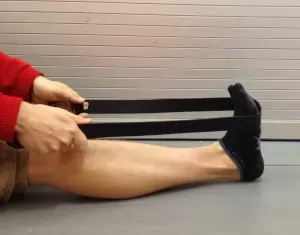
Seated march
- With your back straight, take a seat on a supportive chair.
- Maintain a hip-width distance between your flat feet on the ground.
- To use your core muscles, take a seat a little bit away from the chair’s back.
- Maintain proper posture during the workout by gently contracting your abdominal muscles.
- Lift one knee slowly toward your chest while maintaining your foot off the ground.
- Without falling or straining, raise it as high as you can comfortably.
- Lower your foot back down to the floor slowly and gently.
- Repeat the motion with the opposite leg right away.
- Keep moving your legs in a smooth, marching manner.
- Then return to your neutral position.
- Then relax.
- Repeat these exercises 5 to 10 times.
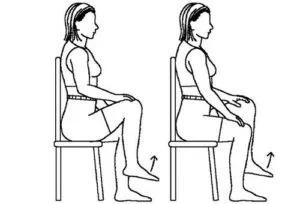
Lying Hamstring stretch
- On a mat or other soft surface, lie on your back.
- Your feet should be flat on the floor when you bend your knees.
- With your knee bent, raise one leg off the ground.
- Holding the ends, you may wrap a yoga band, strap, or towel around the middle of your foot.
- Your leg should be gently straightened toward the ceiling.
- Pull your leg closer to your body as you go, using your hands or the towel.
- A stretch should be felt down your thigh’s back.
- The stretch ought to be a slow, gentle pull.
- Hold this position for a few seconds.
- Return to the starting position by lowering your leg gradually.
- Then return to your neutral position.
- Then relax.
- Repeat these exercises 5 to 10 times.
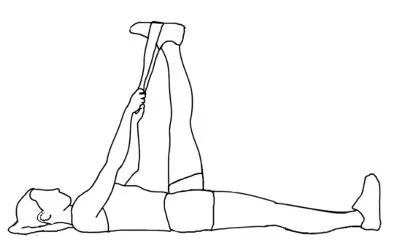
Sit to standing
- Choose a stable chair.
- Additional support from an armrest-equipped chair might be helpful in the beginning.
- Your feet should be flat on the floor when you sit on the chair’s edge.
- Lean your hips forward a little.
- Lift your hips off the chair by using your core and pushing through your feet.
- Make use of your leg strength to move yourself to a standing posture.
- Maintain a straight back and an upright posture.
- After you are completely upright, take a moment to balance yourself.
- Using your hips as a bend, slowly and carefully lower yourself back into the chair.
- Your muscles are used more when you move more slowly.
- Then return to your neutral position.
- Then relax.
- Repeat these exercises 5 to 10 times.
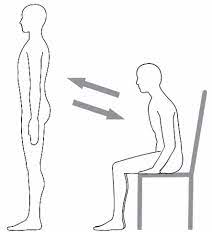
What safety measures need to be followed when working out?
Start slowly and work your way up.
- Begin with short, five to ten-minute, low-intensity sessions.
- Instead of following a set schedule, raise the duration or intensity just when your body is prepared.
Use the Proper Footwear
- Put on non-slip, supportive shoes, particularly if you’re working on your mobility or balance.
Exercises ought to be adjusted for present skill levels.
- If you have trouble standing, try sitting or swimming.
- Begin with range-of-motion exercises and gentle stretching before beginning strength or cardio training.
Keep Your Posture Correct
- Core-strengthening workouts are essential since posture can be affected by muscular weakness.
- All other motions have a solid basis when the core is strong.
Take Regular Breaks
- Incorporate rest periods in between sessions or between workouts.
- To prevent fatigue and allow for a full recovery, schedule rest days.
When necessary, make use of supportive equipment.
- Walking tools, orthotics, and braces can all help lower the risk of strain and falls.
- Exercise equipment such as sitting steppers and recumbent bikes provides constant low-impact action.
Reliability Above Intensity
- Frequent, mild exercise is significantly more advantageous than temporary, strenuous training.
Use a mirror.
- If at all possible, examine your form and posture in front of a mirror.
- This might assist you in resolving any imbalances or incorrect motions.
Pay Attention to Your Body
- Stop a workout right away if it hurts.
- Muscle or nerve injury might result from pushing through pain.
Don’t Overstretch
- A muscle should never be stretched till it hurts.
- This may delay healing and result in small tears.
When did you quit working out?
Here are several clear conditions where you need to stop exercising, depending on your symptoms, level of fatigue, and overall response to exercise:
Enhanced weakness
- Any noticeable loss of strength, particularly in muscles that have already healed, may be a sign of overwork weakness, which is a particular risk factor for GBS.
Incorrect Form
- Your muscles are too weak for that specific action if you can’t keep up the right form during an activity.
- Holding bad form might result in harm.
Lack of breath or dizziness
- You should immediately stop exercising if you experience lightheadedness, dizziness, or difficulty breathing.
- These could be signs of cardiac strain or poor oxygenation.
Pain or Cramming
- Mild muscle soreness is normal, but cramping or persistent, severe pain is not.
- Pain may be a sign of muscle tension, nerve irritation, or improper technique.
Tingling or numbness increases
- If you experience worsening burning, tingling, or numbness, stop immediately.
- These symptoms might point to nerve irritation or stress.
Extreme Fatigue
- People with GBS frequently feel very tired.
- Overwhelming fatigue is an indication that your body wants to take a break rather than make more effort.
- Your recovery may suffer if you force yourself to endure this kind of fatigue.
Worsening Symptoms
- You should stop working out right away and speak with a healthcare professional if you see that your tingling, muscular weakness, or other GBS symptoms are growing worse.
Which workouts should you stay away from if you have haveGuillain-Barrée Syndrome (GBS)?
When you have Guillain-Barré Syndrome (GBS), certain routines might be harmful or ineffective, particularly when you’re recovering. Unless your doctor clearly approves or modifies them, they should typically be avoided:
High-impact or high-intensity exercises
- Avoid workouts like plyometrics, running, and leaping that put a lot of strain on your muscles and joints.
- These may result in injury or a short delay in your recovery, as well as overexertion and muscular fatigue.
Extended Endurance Exercises
- Marathon cycling, long-distance running, and prolonged hiking
- These might lengthen the recovery period and cause excessive tiredness.
- During GBS rehabilitation, energy saving is essential.
Heavy Lifting and High-Resistance Strength Training
- Bench pressing with heavy loads, deadlifts, and heavy squats
- GBS-affected muscles are more likely to experience injury and recover from stress more slowly.
- Reversing or delaying benefits might occur if they are overloaded too soon.
Exercises That Require Balance Without Assistance
- Outdoor jogging, Bosu ball training, yoga, and tai chi without supervision
- GBS patients frequently have a poor sense of balance.
- Unless modified or assisted, these exercises provide a fall risk.
Summary:
Guillain-Barré syndrome happens when an individual’s immune system targets and damages their nerves. It may impair one’s capacity to do daily tasks. For those with Guillain-Barré syndrome, physiotherapy might be quite important to their recovery. To guarantee a safe and successful recovery process, it is essential to create a customized treatment plan and to approach exercise with caution.
Rehabilitation can be highly helpful for those with Guillain-Barré syndrome as they recover. A personalized treatment plan and a cautious approach to activity and therapy are necessary for a rehabilitation process to be both safe and effective.
After a life-altering disease, exercise helps people restore their independence and confidence in addition to their physical strength. A regular, carefully thought-out fitness regimen, under the supervision of a doctor, is essential for those recovering from Guillain-Barré Syndrome (GBS). People can increase their chances of a complete and significant recovery by being aware of the many stages of recovery and following safe exercise guidelines.
FAQ:
Is exercise recommended for those with Guillain-Barré Syndrome (GBS)?
Muscle weakness, abnormalities of the senses, and alterations in soft tissue length affect posture, balance, joint mobility, and gait. Along with benefits like increased mobility and reduced fatigue, exercising can also improve mental performance in patients with Guillain-Barré Syndrome (GBS).
What are some safe exercises to do when recovering from Guillain-Barré Syndrome (GBS)?
Range-of-motion exercises (to avoid joint stiffness), gently stretching, and Body weight supported by water is known as aquatic treatment. Low-intensity resistance training (after muscle recovery) and supported or seated aerobic exercises like arm swings or bikes.
Does exercise help reduce the fatigue that comes with Guillain-Barré Syndrome (GBS)?
If mild to moderate exercise is carefully balanced with enough sleep, it can eventually help reduce fatigue. Strategies for energy conservation and balance are important.
Guillain-Barré Syndrome (GBS): What causes it?
Although the exact cause is undetermined, infections like the stomach flu or respiratory problems are frequently the first signs of it. It is believed that the attack on the nerves is caused by the body’s immunological reaction to the illness.
What are the primary symptoms of Guillain-Barré Syndrome (GBS)?
A tingling or “pins and needles” feeling in the hands and feet is frequently the first sign of the condition. The legs, arms, and face were then affected as the weakness and feeling moved higher. In extreme situations, it may affect the swallowing and breathing muscles.
How much time does it take to recover from Guillain-Barré Syndrome (GBS)?
The duration of recovery might range from a few weeks to many years. The majority of patients recover completely or almost completely, although others may experience persistent weakness, numbness, or fatigue.
Is exercise necessary for the recovery from Guillain-Barré Syndrome (GBS)?
Indeed, exercise and physical rehabilitation are essential. They assist people in relearning how to carry out everyday tasks, increasing their mobility, and regaining their strength. A workout regimen has to be customized for each person’s stage of recovery.
Why is exercise important for the recovery from Guillain-Barré Syndrome (GBS)?
Exercise is beneficial.
Regain your strength and flexibility.
Avoid muscular atrophy and tight joints.
Improve your coordination and balance.
Increase energy and mental well-being.
Which kinds of workouts are best for recovering from Guillain-Barré Syndrome (GBS)?
Exercises for range of motion (passive/active)
To prevent contractures, stretch.
Training with resistance (mild and progressive).
Training for balance and coordination.
Low-impact aerobic exercises, such as cycling or walking
When exercising, how long does it take to restore strength?
Timelines for recovery change. While some people recover their mobility in months, others may need years. Professional advice and consistency are essential.
How frequently should I work out?
Intensity is not as crucial as consistency. Short, numerous sessions are frequently better than one lengthy, stressful session. It’s important to pace yourself to prevent feeling exhausted.
Does Guillain-Barré Syndrome (GBS) benefit from walking?
Increase the distance you walk gradually as your strength and confidence rise. This improves movement even more and helps in endurance building.
Is GBS prevented by exercise?
In Guillain-Barré Syndrome (GBS), exercise may improve strength, lessen fatigue, and encourage functional independence. Exercises for endurance, functional training, and muscular building are frequently suggested therapies.
Which muscles are impacted by Guillain-Barré Syndrome (GBS)?
Paralysis of the muscles in your arms, legs, and face. You could become almost completely paralyzed in extreme situations. Breathing difficulties may result from weakening of the chest muscles.
What part does physiotherapy play in Guillain-Barré Syndrome (GBS)?
In order to help people with Guillain-Barré Syndrome (GBS) regain their strength, mobility, and independence, physiotherapy is essential. Its main goals are to increase respiratory capacity, joint mobility, and muscular function while avoiding side effects, including pressure ulcers and contractures. For those with Guillain-Barré Syndrome (GBS), a customized physiotherapy program can greatly speed up healing and improve quality of life.
References:
- Admin. May 14, 2025. How physical therapy helps Convalescence Syndrome of Guillain-Barré. Physio & Sport Clinic in Emerald Hills. Guillain-Barré Syndrome Recovery with Physiotherapy: https://emeraldhillsphysio.com/
- May 27, 2025a; Bariya, D. 15 The best exercises for GBS (Guillain-Barré syndrome). Physical therapy, exercise, and treatment. Guillain-Barré Syndrome Exercise: https://physical-therapy.us/
- Guillain-Barré Syndrome | Active Healing for Pain-Free Living | CB Physiotherapy Blog, Physical Therapy Restores Muscle Strength and Joint Functions. 2024: Medical care
- May 27, 2024: Mohamoud, H., simplest methods of at-home physical therapy for people with withGuillain-Barréé. Unambiguous physiotherapy. https://www.ccphysiotherapy.com/home-physio/simplest-home-physiotherapy-techniques-for-patients-with guillain barre
- Mohamoud, H. May 27, 2024. Five equipment-free workouts for managing GBS at home. Physiotherapy that is straightforward. The following are some free at-home physiotherapy exercises for managing gbs: https://www.ccphysiotherapy.com/neurological/5
- Guillain-Barré Syndrome Guide | Physical Therapy Guide. July 7, 2023. Select PT. Guillain-Barré Syndrome Physical Therapy Guide https://www.choosept.com/guide
- Sunit, a body therapist, 11 March 2022. 11 simple exercises for Guillain-Barré Syndrome (GBS) that you may do at home [Video]. YouTube. Watch this: https://www.youtube.com/watch?v=fF3iFlAgIvo.
- June 2, 2025: Guillain-Barré Syndrome. Cleveland Medical Center. Guillain-Barre Syndrome https://my.clevelandclinic.org/health/diseases/15838
- Green, T. (April 4, 2023). Can People with Guillain-Barré Syndrome Benefit from Exercise? TG Exercise. Is exercise beneficial for individuals with Guillain-BarréSyndrome? https://www.tgfitness.com/


